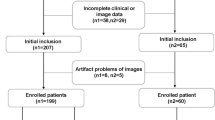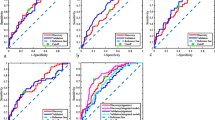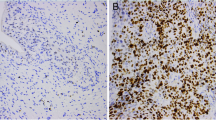Abstract
Objective
To assess the predictive ability of a multi-parametric MRI-based radiomics signature (RS) for the preoperative evaluation of Ki-67 proliferation status in sinonasal malignancies.
Methods
A total of 128 patients with sinonasal malignancies that underwent multi-parametric MRIs at two medical centres were retrospectively analysed. Data from one medical centre (n = 77) were used to develop the predictive models and data from the other medical centre (n = 51) constitute the test dataset. Clinical data and conventional MRI findings were reviewed to identify significant predictors. Radiomics features were determined using maximum relevance minimum redundancy and least absolute shrinkage and selection operator algorithms. Subsequently, RSs were established using a logistic regression (LR) algorithm. The predictive performance of RSs was assessed using calibration, decision curve analysis (DCA), accuracy, and AUC.
Results
No independent predictors of high Ki-67 proliferation were observed based on clinical data and conventional MRI findings. RS-T1, RS-T2, and RS-T1c (contrast enhancement T1WI) were established based on a single-parametric MRI. RS-Combined (combining T1WI, FS-T2WI, and T1c features) was developed based on multi-parametric MRI and achieved an AUC and accuracy of 0.852 (0.733–0.971) and 86.3%, respectively, on the test dataset. The calibration curve and DCA demonstrated an improved fitness and benefits in clinical practice.
Conclusions
A multi-parametric MRI-based RS may be used as a non-invasive, dependable, and accurate tool for preoperative evaluation of the Ki-67 proliferation status to overcome the sampling bias in sinonasal malignancies.
Key Points
• Multi-parametric MRI-based radiomics signatures (RSs) are used to preoperatively evaluate the proliferation status of Ki-67 in sinonasal malignancies.
• Radiomics features are determined using maximum relevance minimum redundancy (mRMR) and least absolute shrinkage and selection operator (LASSO) algorithms.
• RSs are established using a logistic regression (LR) algorithm.





Similar content being viewed by others
Abbreviations
- 3D-ROI:
-
Three-dimensional region of interest
- AUC:
-
Area under the curve
- DCA:
-
Decision curve analysis
- DKI:
-
Diffusion kurtosis imaging
- FS-T2WI:
-
Fat-suppressed T2-weighted images
- ICC:
-
Intraclass correlation coefficient
- Kmax:
-
Maximum kurtosis
- LASSO:
-
Least absolute shrinkage and selection operator
- LR:
-
Logistic regression
- mRMR:
-
Maximum relevance minimum redundancy
- RS:
-
Radiomics signature
- T1c:
-
Contrast-enhanced T1
- T1WI:
-
T1-weighted images
- TE:
-
Echo time
- TR:
-
Repetition time
References
Bracigliano A, Tatangelo F, Perri F et al (2021) Malignant sinonasal tumors: update on histological and clinical management. Curr Oncol 28:2420–2438
Raghavan P, Phillips CD (2007) Magnetic resonance imaging of sinonasal malignancies. Top Magn Reson Imaging 18:259–267
Resto VA, Deschler DG (2004) Sinonasal malignancies. Otolaryngol Clin North Am 37:473–487
Day TA, Beas RA, Schlosser RJ et al (2005) Management of paranasal sinus malignancy. Curr Treat Options Oncol 6:3–18
Mody MD, Saba NF (2020) Multimodal therapy for sinonasal malignancies: updates and review of current treatment. Curr Treat Options Oncol 21:4
Khademi B, Moradi A, Hoseini S, Mohammadianpanah M (2009) Malignant neoplasms of the sinonasal tract: report of 71 patients and literature review and analysis. Oral Maxillofac Surg 13:191–199
Valente G, Mamo C, Bena A et al (2006) Prognostic significance of microvessel density and vascular endothelial growth factor expression in sinonasal carcinomas. Hum Pathol 37:391–400
Shen W, Sakamoto N, Yang L (2017) Prognostic models and nomograms for predicting survival of patients with maxillary sinus carcinomas. Int Forum Allergy Rhinol 7:741–748
Airoldi M, Garzaro M, Valente G et al (2009) Clinical and biological prognostic factors in 179 cases with sinonasal carcinoma treated in the Italian Piedmont region. Oncology 76:262–269
Chen X, He C, Han D et al (2017) The predictive value of Ki-67 before neoadjuvant chemotherapy for breast cancer: a systematic review and meta-analysis. Future Oncol 13:843–857
Classe M, Burgess A, El Zein S et al (2019) Evaluating the prognostic potential of the Ki67 proliferation index and tumour-infiltrating lymphocytes in olfactory neuroblastoma. Histopathology 75:853–864
Chen WJ, He DS, Tang RX, Ren FH, Chen G (2015) Ki-67 is a valuable prognostic factor in gliomas: evidence from a systematic review and meta-analysis. Asian Pac J Cancer Prev 16:411–420
Kim DK, Kim DW, Kim SW et al (2008) Ki67 antigen as a predictive factor for prognosis of sinonasal mucosal melanoma. Clin Exp Otorhinolaryngol 1:206–210
Jansen EP, Keus RB, Hilgers FJ et al (2000) Does the combination of radiotherapy and debulking surgery favor survival in paranasal sinus carcinoma? Int J Radiat Oncol Biol Phys 48:27–35
Dirix P, Nuyts S, Vanstraelen B et al (2007) Post-operative intensity-modulated radiotherapy for malignancies of the nasal cavity and paranasal sinuses. Radiother Oncol 85:385–391
Helsel JC, Bardales RH, Mukunyadzi P (2003) Fine-needle aspiration biopsy cytology of malignant neoplasms of the sinonasal tract. Cancer 99:105–112
Hayashi T, Hirokawa M, Higuchi M et al (2020) Needle tract implantation following fine-needle aspiration of thyroid cancer. World J Surg 44:378–384
Gillies RJ, Kinahan PE, Hricak H (2016) Radiomics: images are more than pictures, they are data. Radiology 278:563–577
Lambin P, Rios-Velazquez E, Leijenaar R et al (2012) Radiomics: extracting more information from medical images using advanced feature analysis. Eur J Cancer 48:441–446
Thrall JH, Li X, Li Q et al (2018) Artificial intelligence and machine learning in radiology: opportunities, challenges, pitfalls, and criteria for success. J Am Coll Radiol 15:504–508
Wu G, Woodruff HC, Shen J et al (2020) Diagnosis of invasive lung adenocarcinoma based on chest CT radiomic features of part-solid pulmonary nodules: a multicenter study. Radiology 297:451–458
Wang H, Zhang J, Bao S et al (2020) Preoperative MRI-based radiomic machine-learning nomogram may accurately distinguish between benign and malignant soft-tissue lesions: a two-center study. J Magn Reson Imaging 52:873–882
Ji GW, Zhu FP, Xu Q et al (2020) Radiomic features at contrast-enhanced CT predict recurrence in early stage hepatocellular carcinoma: a multi-institutional study. Radiology 294:568–579
Bi SC, Zhang H, Wang HX et al (2021) Radiomics nomograms based on multi-parametric MRI for preoperative differential diagnosis of malignant and benign sinonasal tumors: a two-centre study. Front Oncol 11:659905
Zhou B, Xu J, Tian Y, Yuan S, Li X (2018) Correlation between radiomic features based on contrast-enhanced computed tomography images and Ki-67 proliferation index in lung cancer: A preliminary study. Thorac Cancer 9:1235–1240
Liang C, Cheng Z, Huang Y et al (2018) An MRI-based radiomics classifier for preoperative prediction of Ki-67 status in breast cancer. Acad Radiol 25:1111–1117
Zhang QW, Gao YJ, Zhang RY et al (2020) Personalized CT-based radiomics nomogram preoperative predicting Ki-67 expression in gastrointestinal stromal tumors: a multicenter development and validation cohort. Clin Transl Med 9:12
Xiao Z, Zhong Y, Tang Z et al (2018) Standard diffusion-weighted, diffusion kurtosis and intravoxel incoherent motion MR imaging of sinonasal malignancies: correlations with Ki-67 proliferation status. Eur Radiol 28:2923–2933
Yushkevich PA, Yang G, Gerig G (2016) ITK-SNAP: an interactive tool for semi-automatic segmentation of multi-modality biomedical images. Annu Int Conf IEEE Eng Med Biol Soc 2016:3342–3345
Depeursinge A, Foncubierta-Rodriguez A, Van De Ville D, Muller H (2014) Three-dimensional solid texture analysis in biomedical imaging: review and opportunities. Med Image Anal 18:176–196
Fedorov A, Beichel R, Kalpathy-Cramer J et al (2012) 3D Slicer as an image computing platform for the Quantitative Imaging Network. Magn Reson Imaging 30:1323–1341
Lucia F, Visvikis D, Vallieres M et al (2019) External validation of a combined PET and MRI radiomics model for prediction of recurrence in cervical cancer patients treated with chemoradiotherapy. Eur J Nucl Med Mol Imaging 46:864–877
Orlhac F, Frouin F, Nioche C, Ayache N, Buvat I (2019) Validation of a method to compensate multicenter effects affecting CT radiomics. Radiology 291:53–59
Pulickal GG, Navaratnam AV, Nguyen T et al (2018) Imaging sinonasal disease with MRI: providing insight over and above CT. Eur J Radiol 102:157–168
Zhang J, Yao K, Liu P et al (2020) A radiomics model for preoperative prediction of brain invasion in meningioma non-invasively based on MRI: a multicentre study. EBioMedicine 58:102933
Lee J, Wang N, Turk S et al (2020) Discriminating pseudoprogression and true progression in diffuse infiltrating glioma using multi-parametric MRI data through deep learning. Sci Rep 10:20331
Funding
The authors state that this work has not received any funding.
Author information
Authors and Affiliations
Corresponding authors
Ethics declarations
Guarantor
The scientific guarantor of this publication is Dapeng Hao.
Conflict of interest
The authors of this manuscript declare no relationships with any companies, whose products or services may be related to the subject matter of the article.
Statistics and biometry
One of the authors (Jie Li) has significant statistical expertise.
Informed consent
Written informed consent was waived by the Institutional Review Board.
Ethical approval
Institutional Review Board approval was obtained.
Methodology
• retrospective
• diagnostic or prognostic study
• multicentre study
Additional information
Publisher’s note
Springer Nature remains neutral with regard to jurisdictional claims in published maps and institutional affiliations.
Rights and permissions
About this article
Cite this article
Bi, S., Li, J., Wang, T. et al. Multi-parametric MRI-based radiomics signature for preoperative prediction of Ki-67 proliferation status in sinonasal malignancies: a two-centre study. Eur Radiol 32, 6933–6942 (2022). https://doi.org/10.1007/s00330-022-08780-w
Received:
Revised:
Accepted:
Published:
Issue Date:
DOI: https://doi.org/10.1007/s00330-022-08780-w




